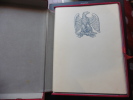Napoléon
Second tirage, Club du Livre d'Histoire. 1955. . Album illustré de 97 documents tirés des Collections Nationales Raymond Guyot (introduction et notes), feuillets sous chemise sous emboîtage en velours rouge. L'étui présente des signes de faiblesse.
Reference : ZNF-861
Bookseller's contact details
Bouquinerie Kontrapas
Mme Béatrice Candy-Bercetche
36 Rue Bourgneuf
64100 Bayonne
France
05 59 25 43 72
Payment mode
Sale conditions
Règlement par chèque ou virement, expédition du livre à réception du règlement. Les commandes (courriel, téléphone ou courrier postal) sont traitées dans l'ordre de réception.
5 book(s) with the same title
NAPOLEON // MAUROIS (André) / GALLOIS (Pierre M.) / MORAND (Paul) (Préfacés par)
Reference : 10691
Napoléon par Napoléon - Tomes I & 2 : Dictionnaire ou Recueil alphabétique des opinions et jugements de Napoléon Ier. Tome 3 : L'Art de la guerre de Napoléon Ier. Tome 4 : Précis des guerres de Napoléon Ier
Paris, Au Club de l'Honnête Homme, 1964-65. 4 vol. in-8 reliés percaline rouge, ornement et filets dorés, rhodoïd. Pages de garde en suédine verte. Illustrations. Exemplaire No 1599 / 3000. Tirage limité sur Vergé Gothique blanc. Edition originale. Très bon état.
Napoléon par Napoléon. Dictionnaire ou Recueil alphabétique des opinions et jugements de Napoléon 1er. L'Art de la guerre de Napoléon 1er. Précis des guerres de Napoléon 1er
Au Club de l'honnête Homme Au Club de l'Honnête Homme 1964. 4 volumes In-8 reliure éditeur pleine peau rouge gravée à l'or fin par Boutan-Marguin à l'aide fers originaux, dos à filets dorés, filets d'encadrement dorés sur les plats, monogramme doré sur les plats, gardes de suédine verte, rhodoids, chaque volume d'environ 350 pages. Illustrations. Préfaces par André MAUROIS, Maurice SCHUMANN, Pierre M. GALLOIS et Paul MORAND. Edition originale sur vergé gothique blanc des papeteries de Prioux numérotée (N°1685). Bien complet, bon état.
Toutes les expéditions sont faites en suivi au-dessus de 25 euros. Expédition quotidienne pour les envois simples, suivis, recommandés ou Colissimo.
Dictionnaire ou Recueil alphabétique des opinions et jugements de Napoléon Ier.
Club de l'honnête homme, 1964-1965. Ensemble complet de 4 volumes in-8 reliés (21,8 x 14 cm), reliure éditeur plein chagrin rouge, titre et filets sur le dos, filets d'encadrement dorés sur les plats, tête dorée, XXXII-310, XIII-399, XXV-465 et XIV-345 pages, quelques illustrations, préface de Paul Morand. Tomes 1 et 2. Dictionnaire ou Recueil alphabétique des opinions et jugements de Napoléon Ier. Préfaces d'André Maurois et de Maurice Schumann - Tome 3. L'Art de la guerre. Préface de Pierre M. Gallois - Tome 4. Précis des guerres. Préface de Paul Morand. - L'un des 200 exemplaires numérotés en chiffres romains (n° LVI), dont le premier plat est incrusté d'une médaille en bronze frappée spécialement par l'Hôtel de la Monnaie.- 2770g.C. - Intérieur bien frais, dos lég. décoloré, très bon état
Napoléon par Napoléon. Dictionnaire ou recueil alphabétique des opinions et jugements de l'Empereur- L'art de la guerre - Précis des guerres
Club de l'Honnête Homme Club de l'Honnête Homme, 1964 -1965. 4 volumes In-8 reliés plein cuir rouge éditeur à filets dorés en dos et sur les plats, gardes de suédine verte, sous rhodoïd. XXXII + 330 + XIII + 350 pages pour les deux volumes qui composent le dictionnaire + XXIX + 466 pages pour l'Art de la guerre et XIV + 350 pages pour le Précis des guerres. Illustrations. Ensemble bien complet et en très bon état.
Toutes les expéditions sont faites en suivi au-dessus de 25 euros. Expédition quotidienne pour les envois simples, suivis, recommandés ou Colissimo.
LETTRE MANUSCRITE SIGNEE DE NAPOLEON CONCERNANT LA COMMISSION DES SEQUESTRES.MADRID.1810
4 feuillets in-4 intitulés " Notte extraite de la correspondance de la Commission Impériale des Séquestres et Indemnités établie à Madrid du 2 Septembre 1810.Renvoyé au Major général pour en faire un rapport et donner des ordres.Paris le 10 février 1811.Signature de Napoléon.2 écritures.ll y est question aussi d'Andalousie,d'oranges et du troupeau impérial.TBE.
 Write to the booksellers
Write to the booksellers






